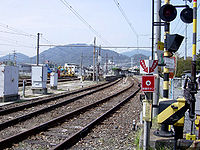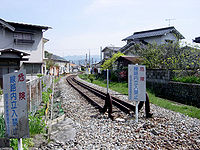
Kabe Station (Hiroshima)
Encyclopedia




West Japan Railway Company
, also referred to as , is one of the Japan Railways Group companies and operates in western Honshū. It has its headquarters in Kita-ku, Osaka.-History:...
Kabe Line
Kabe Line
The is a rail line operated by JR West within the city of Hiroshima, Hiroshima Prefecture, Japan. It begins at Hiroshima Station and terminates at Kabe Station in Asakita-ku. It is one of the commuter lines to Hiroshima. Prior to December 1, 2003, the line was connected to Sandankyō Station from...
terminal
Terminal Station
Terminal Station is a 1953 film by Italian director Vittorio De Sica. It tells the story of the love affair between an Italian man and an American woman. The film was entered into the 1953 Cannes Film Festival.-Production:...
station
Train station
A train station, also called a railroad station or railway station and often shortened to just station,"Station" is commonly understood to mean "train station" unless otherwise qualified. This is evident from dictionary entries e.g...
located in 2-chōme, Kabe, Asakita-ku
Asakita-ku, Hiroshima
is one of the eight wards of the city of Hiroshima, located in the North of Asa-gun and the South of Takata-gun: now-defunct districts .Asa-gun was consisted of Kabe-cho, Kōyō-cho, Asa-cho. Takata-gun was including Shiraki-cho...
, Hiroshima, Hiroshima Prefecture
Hiroshima Prefecture
is a prefecture of Japan located in the Chūgoku region on Honshu island. The capital is the city of Hiroshima.- History :The area around Hiroshima was formerly divided into Bingo Province and Aki Province. This location has been a center of trade and culture since the beginning of Japan's recorded...
, Japan
Japan
Japan is an island nation in East Asia. Located in the Pacific Ocean, it lies to the east of the Sea of Japan, China, North Korea, South Korea and Russia, stretching from the Sea of Okhotsk in the north to the East China Sea and Taiwan in the south...
. As of 2003-12-01, Kabe Station is the terminal station
Terminal Station
Terminal Station is a 1953 film by Italian director Vittorio De Sica. It tells the story of the love affair between an Italian man and an American woman. The film was entered into the 1953 Cannes Film Festival.-Production:...
of the Kabe Line. It replaced Sandankyō Station
Sandankyo Station
was a JR West Kabe Line terminal station located in Akiota, Hiroshima, Japan. It closed on December 1, 2003 when operation of the line was discontinued/suspended between Kabe Station and Sandankyō Station.The station had one side platform.-External links:...
after the Kabe Line beyond Kabe Station was suspended.
History
- 1911-07-13: The Imperial Railroad Hiroshima Branch Office Station opens
- 1919-03-11: The station becomes part of Kabe Railroad
- 1926-05-01: Kabe Railroad merges with Hiroshima Denki and the station ownership is transferred with the merger
- 1928-11-09: Service from Furuichibashi StationFuruichibashi Stationis a JR West Kabe Line station located in 3-chōme, Furuichi, Asaminami-ku, Hiroshima, Hiroshima Prefecture, Japan.-History:*1909-11-19: Furuichibashi Station opens...
is suspended while track electrification takes place, buses handles service during this time - 1929-12-02: Service begins again after the completion of the electrification work
- 1931-07-01: The station becomes part of Kōhama Railway
- 1935-12-01: The station is renamed Kōhama Kabe Station
- 1936-09-01: The station is renamed Kabe Station when it is nationalized
- 1936-10-13: The line between Aki-Imuro StationAki-Imuro Stationis a former JR West Kabe Line station located in Asakita-ku, Hiroshima, Hiroshima Prefecture, Japan. It closed on December 1, 2003 when operation of the line was discontinued/suspended between Kabe Station and Sandankyō Station.- Adjacent stations :...
and Kabe Station is opened, making Kabe Station an intermediate station - 1987-04-01: Japanese National RailwaysJapanese National Railways, abbreviated or "JNR", was the national railway network of Japan from 1949 to 1987.-History:The term Kokuyū Tetsudō "state-owned railway" originally referred to a network of railway lines operated by nationalized companies under the control of the Railway Institute following the nationalization...
is privatized, and Kabe Station becomes a JR West station - 2003-12-01: Service on the 46.2km rail line segment from Kabe Station to Sandankyō StationSandankyo Stationwas a JR West Kabe Line terminal station located in Akiota, Hiroshima, Japan. It closed on December 1, 2003 when operation of the line was discontinued/suspended between Kabe Station and Sandankyō Station.The station had one side platform.-External links:...
is suspended, making Kabe Station the terminal station of the Kabe Line
Kabe Station was formerly the boundary between the electrified and non-electrified sections of the Kabe Line. The non-electrified section of the line is now out of service.
Station building
Kabe Station features two platforms capable of handling three lines simultaneously. Platforms one and two are bay platformBay platform
Bay platform is a railway-related term commonly used in the UK and Australia to describe a dead-end platform at a railway station that has through lines...
s, and all three service trains headed to Hiroshima Station
Hiroshima Station
is a JR West railway station located in Minami-ku, Hiroshima, Japan. Hiroshima Station is the terminal station for several lines, and all Sanyō Shinkansen trains stop here.-History:...
. During the day, the trains are handled at platform two. During the morning and evening, the trains are handled at platforms one and three. Before the segment was closed, platform three handled trains bound for Sandankyō Station
Sandankyo Station
was a JR West Kabe Line terminal station located in Akiota, Hiroshima, Japan. It closed on December 1, 2003 when operation of the line was discontinued/suspended between Kabe Station and Sandankyō Station.The station had one side platform.-External links:...
because it was the only through platform. The line at platform three which formerly continued on to Sandankyō Station has been severed and turned into a buffer stop
Buffer stop
A buffer stop or bumper is a device to prevent railway vehicles from going past the end of a physical section of track.The design of the buffer stop is dependent in part upon the kind of couplings that the railway uses, since the coupling gear is the first part of the vehicle that the buffer stop...
(or "bumper") to keep the train from proceeding (see photo on right).
Prior to 2006, the unisex
Unisex
Unisex stands for the meaning that either gender or sex will be able to, but can also be another term for gender-blindness.The term was coined in the 1962 and was used fairly informally...
restroom was found outside the station before passing through the ticket gates. While the station is located within the city of Hiroshima, this restroom featured a pit-style toilet
Pit toilet
A pit toilet is a dry toilet system which collects human excrement in a large container and range from a simple slit trench to more elaborate systems with ventilation. They are more often used in rural and wilderness areas as well as in much of the developing world...
which had to be pumped regularly in order to remove the accumulated waste. The station had developed somewhat of a bad reputation because of this due to the lingering odor. This issue was resolved in 2006, however, with the completion of gender-specific restrooms featuring standard flush toilet
Flush toilet
A flush toilet is a toilet that disposes of human waste by using water to flush it through a drainpipe to another location. Flushing mechanisms are found more often on western toilets , but many squat toilets also are made for automated flushing...
s connected to the city's sewer system
Sewage collection and disposal
Sewage collection and disposal systems transport sewage through cities and other inhabited areas to sewage treatment plants to protect public health and prevent disease. Sewage is treated to control water pollution before discharge to surface waters....
. Once the new restrooms were completed, the old one was closed.
Environs
- Hiroshima Municipal Kabe Minami Elementary School
- Hiroshima Municipal Kabe High School
- Kabe Station Entrance Bus Station
- Kabe Driving School
- Kabe Public Employment Office
- Doi Clinic
- Ōta RiverOta Riveris one of the most famous and beautiful rivers in Japan.- Overview :Ōta River is a 103 kilometer- long river as its main stream from . The Ōta River is the major river that flows through Hiroshima Prefecture and empties into the Seto Inland Sea...
- JR West Geibi LineGeibi LineThe is a railway line operated by West Japan Railway Company in the mountainous area of the Chūgoku region. It begins at Bitchū Kōjiro Station on the west side of Niimi, Okayama Prefecture, connecting through Miyoshi Station in Miyoshi, Hiroshima Prefecture, and terminating at Hiroshima Station...
Shimofukawa StationShimofukawa Stationis a JR West Geibi Line station located in 5-chōme, Fukawa, Asakita-ku, Hiroshima, Hiroshima Prefecture, Japan. This is the largest of the three Fukawa stations on the Geibi Line, and handles many trains daily.-History:...
is located 1.5km southwest
Highway access
- Japan National Route 54
- Hiroshima Prefectural Route 70 (Hiroshima-Nakashima Route)
- Hiroshima Prefectural Route 177 (Shimosa Higashi Route)
- Hiroshima Prefectural Route 191 (Bingo Akasaka Teishajō Route)
- Hiroshima Prefectural Route 240 (Kabe Teishajō Route)
- Hiroshima Prefectural Route 267 (Utsu-Kabe Route)
- Hiroshima Prefectural Route 270 (Yagi-Midorii Route)
Connecting lines
All lines are JR West lines.Kabe Line
- Nakashima StationNakashima Station (Hiroshima)is a JR West Kabe Line station located in 1-chōme, Kabe-Minami, Asaminami-ku, Hiroshima, Hiroshima Prefecture, Japan.-History:*1911-06-12: Nakashima Station opens*1936-09-01: The station is renamed Aki-Nakashima Station*1943-10-01: Station operations suspended...
— Kabe Station
Kabe Line (supended section)
- Kabe Station — Kōdo StationKodo Station (Hiroshima)is a former JR West Kabe Line station located in 1-chōme 9-ban, Kameyama, Asakita-ku, Hiroshima, Hiroshima Prefecture, Japan. It closed on December 1, 2003 when operation of the line was discontinued/suspended between Kabe Station and Sandankyō Station.-History:...

